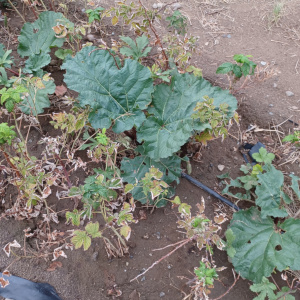

German Wine Rhubarb
Victoria is an easy type to grow that has greenish stalks and frequently puts out flower stalks. In 2018 I planted 6 Victoria Rhubarb starts 5' apart in 1' watering basins and they grew for 2 years without harvesting. I then transplanted to 32" x 22' beds filled with peat moss and 16-16-16 fertilizer mixed in well and drippers spaced every 18" inches. That same year they grew like mad and I got 3 harvests and we made dried rhubarb fruit leather. The next spring I divided the remaining 5 into 25 divisions and using the same beds and I was able to get 4 harvests and couldn't give it away fast enough.
I have planted several newer varieties that are supposed to be "sweeter", redder, and produce fewer flowers. Redder varieties are more popular because many people think that the redder varieties are sweeter though there is no factual basis for this belief. I found one vendor that intermittently sells German Wine Rhubarb and who sent me a horrible looking dried out stump that looked totally dead. I put it in a pot for a couple weeks and a few shoots came out and divided that into 9 starts. After 2 years 5 have survived which I moved to a plastic lined bed where they can get more water, aside from heavy grasshopper damage they are doing well.


Glaskin's Perpetual Rhubarb
Seed
In 2024 we replanted one of our blackberry beds with figs and had many rhuarb sprout from seed. These are from the Victoria rhubarb nearby and having too many I just removed them.
Rhubarb Varieties
- Victoria Rhubarb (vigorous, red-green, easily makes flower stalks)
- Glaskin's Perpetual Rhubarb (very vigorous with mostly green stalks)
- German Wine (purportedly sweetest variety but very hard to find)
- Cherry Red (red stalks)
- Crimson Red (red stalks)
- Chipmans Canada Red (red stalks)
How to Use Rhubarb
Some people just clean the rhubarb, dip the end in some sugar, and it it raw. Another simple way is to make a thick or thin sauce. For thick sauce chop rhubarb into 1 inch or smaller lengths and add 1/4 cup of sugar for every 1 cup of chopped rhubarb, no water needed just let them sit to express their own juices. Use as pie filling by itself, or mixed with apple pie filling, or let the juices come out of the rhubarb and cook on very low heat till soft. Take care as unthinned sauce will burn easily. This mixture can be blended and made into a thin layer in a dehydrator to make rhubarb "fruit" leather with or without other fruit such as apples. To make thinner sauce add about 1/2 a cup of water before cooking. Thinner sauce is good to accompany meat, can be used as a jam, or with anything that would benefit from a sweet and sour side condiment.